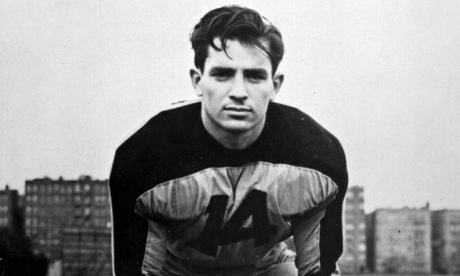
“I shall worship her with quiet dignity. I shall draw her attention to me by exploits, success, and possibly a small measure of fame,” wrote a young, romantically inclined Jack Kerouac to a friend in one of a cache of letters by the Beat author that has come to light.
The 17 complete letters, two postcards and seven substantial fragments by the author of On the Road were found by the daughter of George J Apostolos after his death. Apostolos was a childhood friend of Kerouac’s from Lowell, Massachusetts. The author wrote to Apostolos from Horace Mann, the New York City prep school to which he had won a football scholarship, and from Columbia University, largely between 1940 and 1941, when he would have been in his late teens. The letters were written on a typewriter and run for up to five pages of single-spaced, dense type.
According to auction house Skinner, which will put the cache up for auction this autumn, they show Kerouac in the process of “becoming Kerouac”. In one letter written from Columbia in the spring of 1941, the teenager tells his friend: “I’m planning to bum home one of these weekends, and to return almost immediately. Just a Saturday and Sunday in Lowell. It always appeals to me,” he writes, adding in red ink: “because that is where the road began.”
In another, signed “your eccentric pal, Jack”, he records in minute detail the charms of the sister of a friend, his “dream girl”, whom he intends to marry.
“There is no doubt in my mind that you or I have never laid our eyes on such an exquisite creature as Jacqueline Sheresky,” he rhapsodises. “Her neck has that stamp of blueblood; it curves up delicately and like ivory to a perfectly moulded almond chin, and thence to quivering scarlet lips, covering a row of alabaster teeth. Her eyes are dark as ebony, with a flash of fire in them. Her hair topples down in rippling cascades of black sleekness, over a pair of resilient, lush shoulders. She is slim, blooming and graceful; I have never seen anything like it.”
Announcing his plans to “worship her with quiet dignity” and gain her notice “by exploits, success, and possibly a small measure of fame”, the young Kerouac veers between romance and practicality. “The trouble with me is, that I haven’t the nerve to ask her to the Senior Prom ... Were I to escort this Goddess to the Waldorf, I would have my measure of life poured into one night,” he writes. “I am afraid that God-damned Jew Sokolow has already asked her.”
The girl is later spotted by Kerouac dancing with Sokolow. He raises his hand “slowly” and waves at her. She returns the salute. “What a Goddamned sordid, hopelessly awkward, hypocritical, idealistic, self-conscious and crazy fool am I ... But I know that you understand me, and that you won’t hold it against me if I pour out all my kaleidoscopic nonsense into your vast basin of human intelligence,” Kerouac tells Apostolos, whose connection to the writer had been “lost to biographers”, according to Skinner, “chiefly because these letters have never been available to researchers or the public”.
Kerouac is clearly not entirely devoted to his latest discovery: later in the letter, he tells Apostolos of a date with a “cute little blonde”, and appears to be trying to persuade his friend to “lay” a woman called Leo, because “if you lay Leo before I get back, then when I do get back she will have fallen into the habit of laying the young cocks that visit her house, and I will join the fold. So go to it ... Lay her you babe, and we’ll have a twice weekly fuck for the rest of our lives, which is really LIVING.”
Skinner, which will offer the letters separately for auction as part of its rare books and manuscripts sale on 16 November, says: “In these letters Kerouac comes through as playful and brilliant, an eager student who seems perfectly at home first in the unfamiliar prep school culture at HM, and later as a freshman at Columbia. He socialises, plays football, writes, reads, speculates, philosophises, and imagines his own future.
“One is also reminded that this is private correspondence exchanged between two teenaged boys in the late 1930s and the early 40s. Kerouac refers to old high school adventures, his homesick love of Lowell, and describes his social exploits, drinking, partying and explorations with girlfriends ... His youthful optimistic enthusiasm and self-doubting frailty are both palpable in these letters. Seeing Kerouac as he makes his first steps out of Lowell, knowing his ultimate trajectory, one reads these letters with a sense of pride and hope in the young artist.”
Devon Gray, director of fine books and manuscripts at Skinner, said that although the letters “were kept for decades without much concern for their well-being”, even the damaged sections contain “unique material that has never been seen or read”. Skinner is expecting the letters to fetch between $2,000 and $5,000 each.
Gray said that Apostolos’s daughter had grown up with Kerouac as a regular visitor to her family home. “Memories of Kerouac from the 1960s are always coloured by his dangerous relationship with alcohol. However, her memories of him are bright and warm,” he said. “She had heard that her father had some letters, but was also told that they had been burned. After her father’s death, [she] discovered this group of letters among his things.”

